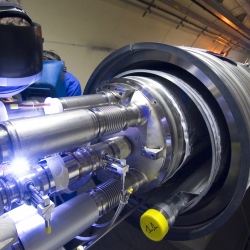
New measurements of the electron have confirmed, to the smallest precision attainable, that it has a perfect roundness. This may sounds nice for the little electron, but to one of the big physics theories beyond the standard model, it’s very bad news.
There currently are many efforts under way to search for physics “beyond” the standard model. The standard model predicts all known quantum interactions to a very high degree of accuracy. But, although being the vanguard for physics for many decades, the standard model does not account for mysterious dark matter and it does not encompass gravity.
One idea that theoretical physicists have pinned their hopes on is supersymmetry, the possible existence of “shadow particle” partners to regular subatomic particles. So, for example, every proton will have a more massive “shadow proton” (or “sproton”). Should these “sparticles” exist, perhaps they might explain the existence of dark matter that we know pervades the entire Universe, but have little idea what it is.
Alas, despite their best efforts in particle accelerators like the Large Hadron Collider (LHC), there is zero evidence of the existence of these sparticles. As if to underline this problem, it turns out that the recently-discovered Higgs boson is a “standard model Higgs” the elusive particle is even predicted via standard model physics. Also, the LHC’s measurements of a rare Bs meson decay only confirmed standard model calculations and did not reveal anything exotic of a supersymmetrical nature.
